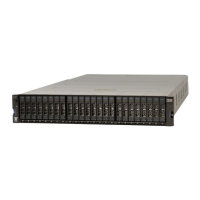v Use the service assistant when you can connect to the service assistant on either
the node canister that you want to configure or on a node canister that can
connect to the node canister that you want to configure:
1. Make the node canister that you want to configure the current node.
2. Select Change Service IP from the menu.
3. Complete the panel.
v Use one of the following procedures if you cannot connect to the node canister
from another node:
– Use the initialization tool to write the correct command file to the USB flash
drive. Go to “Using the initialization tool” on page 207.
– Use a text editor to create the command file on the USB flash drive. Go to
“Using a USB flash drive” on page 207.
Procedure: Initializing a clustered system with a USB flash
drive without using the initialization tool
Use this procedure to initialize a clustered system using a USB flash drive when
you do not have a workstation to run the initialization tool or you do not have a
copy of the tool.
About this task
In these situations, you must manually create an satask.txt file on a USB flash
drive to initialize your clustered system. Use the USB flash drive that was supplied
with your system or any USB flash drive that is formatted with a FAT32 file
system on its first partition. (For a complete list of commands you can use in a
satask.txt file, see “satask.txt commands” on page 209.)
Procedure
1. Open a file editor that can create ASCII text files.
2. Create a file called satask.txt.
3. Add a single line of command text to the file.
If you are creating a clustered system with an IPv4 address, the command line
is like the following string:
satask mkcluster -clusterip aaa.aaa.aaa.aaa
-gw ggg.ggg.ggg.ggg -mask mmm.mmm.mmm.mmm
where you must replace aaa.aaa.aaa.aaa with the management IP address,
ggg.ggg.ggg.ggg with the network gateway address, and mmm.mmm.mmm.mmm
with the subnet mask address.
If you are creating a clustered system with an IPv6 address, the command line
is like the following string:
satask mkcluster -clusterip_6 aaaa:aaaa:aaaa:aaaa:aaaa:aaaa:aaaa:aaaa
-gw_6 gggg:gggg:gggg:gggg:gggg:gggg:gggg:gggg -prefix_6 pp
where you must replace aaaa:aaaa:aaaa:aaaa:aaaa:aaaa:aaaa:aaaa with the
management IPv6 address, gggg:gggg:gggg:gggg:gggg:gggg:gggg:gggg with the
network gateway IPv6 address, and pp with the prefix value.
For other command options, see “Create system command” on page 213.
4. Save the file to a USB flash drive.
5. Plug the USB flash drive into a USB port on a control canister.
272 Storwize V7000 Unified: Problem Determination Guide 2073-720

